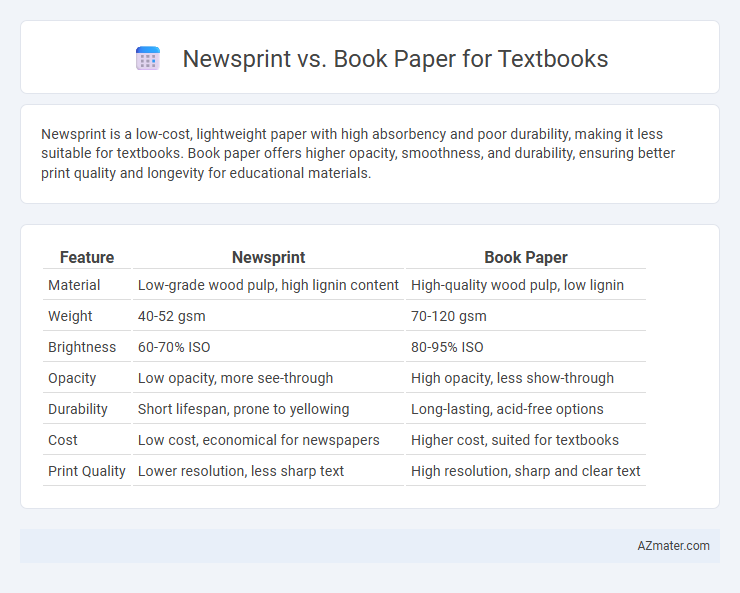Newsprint is a low-cost, lightweight paper with high absorbency and poor durability, making it less suitable for textbooks. Book paper offers higher opacity, smoothness, and durability, ensuring better print quality and longevity for educational materials.
Table of Comparison
| Feature | Newsprint | Book Paper |
|---|---|---|
| Material | Low-grade wood pulp, high lignin content | High-quality wood pulp, low lignin |
| Weight | 40-52 gsm | 70-120 gsm |
| Brightness | 60-70% ISO | 80-95% ISO |
| Opacity | Low opacity, more see-through | High opacity, less show-through |
| Durability | Short lifespan, prone to yellowing | Long-lasting, acid-free options |
| Cost | Low cost, economical for newspapers | Higher cost, suited for textbooks |
| Print Quality | Lower resolution, less sharp text | High resolution, sharp and clear text |
Introduction to Textbook Paper Types
Newsprint and book paper are two primary types of paper used in textbook production, each with distinct characteristics affecting durability and print quality. Newsprint, typically made from lower-grade wood pulp, is cost-effective but prone to rapid yellowing and brittleness, making it less ideal for long-lasting textbooks. Book paper, often produced from higher-quality cellulose fibers, offers superior opacity and surface finish, enhancing readability and ensuring longevity essential for educational materials.
What is Newsprint Paper?
Newsprint paper is an inexpensive, lightweight, and uncoated paper primarily made from wood pulp and designed for high-speed printing of newspapers. It has a lower brightness and opacity compared to book paper, making it less durable but cost-effective for short-term use in educational textbooks. This type of paper absorbs more ink, resulting in lower print quality but faster production suitable for large volumes.
What is Book Paper?
Book paper is a high-quality, acid-free printing paper specifically designed for durability and clarity in textbooks, offering smooth texture and superior opacity to prevent text bleed-through. Unlike newsprint, book paper provides long-lasting brightness and strength, ensuring that educational content remains legible and intact over time. Its refined composition enhances print sharpness, making it ideal for dense text and detailed images within academic materials.
Key Differences: Newsprint vs Book Paper
Newsprint is a low-cost, lightweight paper made from recycled fibers, typically used for newspapers due to its high opacity and rough texture, but it tends to yellow and degrade quickly over time. Book paper, also known as offset paper, is more durable, smoother, and acid-free, designed to withstand frequent handling and preserve text clarity, making it ideal for textbooks and long-lasting printed materials. The key differences lie in durability, texture, and quality, with book paper providing superior longevity and readability compared to the cost-effective but less durable newsprint.
Print Quality and Readability
Newsprint offers lower print quality due to its rough texture and high absorbency, causing ink to bleed and reducing text sharpness in textbooks. Book paper provides superior print clarity with a smoother surface and better ink holdout, resulting in crisp text and enhanced readability for prolonged study sessions. Choosing book paper improves the overall user experience by minimizing eye strain and ensuring consistent legibility throughout dense textbook content.
Durability and Longevity
Book paper offers superior durability and longevity compared to newsprint, making it ideal for textbooks that require frequent handling and prolonged use. Newsprint, typically made from lower-quality wood pulp with high acidity, tends to yellow and become brittle over time, significantly reducing its lifespan. The higher acid-free content and denser fibers of book paper ensure that textbooks maintain their structural integrity and readability for many years.
Environmental Impact and Sustainability
Newsprint paper, commonly made from non-recycled wood pulp, has a lower production cost but poses significant environmental concerns due to high energy consumption and deforestation. Book paper often incorporates recycled fibers and sustainable forestry practices, reducing carbon footprint and promoting forest conservation. Choosing book paper for textbooks supports environmental sustainability by lowering waste generation and encouraging renewable resource use.
Cost Comparison and Budget Considerations
Newsprint offers a significantly lower cost per page compared to book paper, making it an economical choice for large-volume textbook printing. Book paper, while more expensive, provides higher durability and better print quality, impacting long-term budget allocations for textbook production. Choosing between newsprint and book paper requires balancing initial printing expenses against the expected lifespan and readability needs of the textbook.
User Experience: Students and Educators
Newsprint offers a lightweight and cost-effective option for textbooks but often sacrifices durability and print clarity, impacting long-term usability for students. Book paper provides a smoother texture and higher opacity, enhancing readability and reducing eye strain during extended study sessions for both students and educators. Choosing book paper supports a more comfortable and effective learning experience, despite higher production costs.
Choosing the Right Paper for Textbooks
Choosing the right paper for textbooks involves balancing durability, readability, and cost-effectiveness. Newsprint is an economical option with lower brightness and durability, making it suitable for short-term use or disposable materials, while book paper offers higher opacity, brightness, and strength, enhancing the reader's experience and longevity of the textbook. Selecting book paper ensures better print quality and resistance to wear, critical for long-term academic resources.

Infographic: Newsprint vs Book Paper for Textbook
 azmater.com
azmater.com